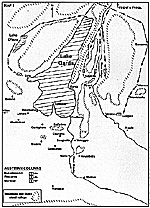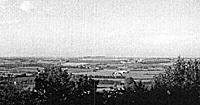At the end of July, 1796, we find that Napoleon had successfully knocked the Piedmontese out of the war, forced the retreat of the Austrians under General Johann Beaulieu, and was now besieging Mantua; an Austrian held fortress that was turning out to be a very hard nut to crack. It contained 12,700 men commanded by Feldmarschall Leutnant Canto d'Irles and was considered the key to Austrian control of Northern Italy. Not surprising, the Austrians were determined to break the siege. The battle of Castiglione on the 5th of August, 1796, was the result of the first of many attempts to do so.
There is no doubt that on both sides the men must have been tough, both physically and mentally. The difference and consequent result of the engagements, came mainly from how the various officers and Commander in Chiefs handled them. Unfortunately for the Austrians, the logic of the Austrian High Command seemed to be exactly the opposite of that of Napoleon's. where he would attempt to concentrate as many men as possible into one area the Austrians preferred to divide their forces. A mistake that was to prove them costly time and time again.
 And so it was that near the end of July the Austrians divided their forces into three columns. (See MAP 1 at right).
And so it was that near the end of July the Austrians divided their forces into three columns. (See MAP 1 at right).
One column, commanded by General Peter Quasdanovich, with around 18,000 men, advanced down the West side of Lake Garda towards Salo, which they succeeded in capturing. A larger force, itself divided into three columns, commanded by Commander in Chief, (FM) Feldmarschall Count Dagobert Wurmser, with around 25,000 men (which included remnants of Beaulieu's force) advanced down the Eastern side towards Verona. Further east, advancing down the Brenta Valley, was a smaller third column containing some 5,000 men, commanded by General Meszaros. They were all headed towards the much flatter area at the southern end of the lake.
 (View from castle wall. Simione and Lake Garda in center. Le Clerc with 4th and 5th demi-brigades advanced from left)
(View from castle wall. Simione and Lake Garda in center. Le Clerc with 4th and 5th demi-brigades advanced from left)
The Austrians now had in the Lake Garda area, including the Mantua garrison, around 60,000 men. Facing them was the still ragged army of Napoleon. The most he could muster was around 49,000 men, and this included troops undertaking occupying duties and those besieging Mantua.
Quasdanovich, after capturing Salo, advanced further south and captured Brescia on the 30th July (also capturing one of the future Marshals, General Joachim Murat in the process) and so threatened Napoleon's lines of communication with Milan. Reluctantly, on the 31st, Napoleon ordered the siege to be lifted. It was quite a risk leaving the Austrians almost free range to operate in his rear, even if many of them were sick and low on supplies, but it was a risk he was willing to take. This hasty withdrawal resulted in the loss of 179 guns and much siege equipment. Some guns were spiked and some buried but the Austrians gained the rest. Unfortunately for the Austrians, Wurmser delayed attempting to link up with Quasdanovich until he had definite proof that the siege had been lifted, which didn't reach him until the 1st August. This of course gave a desperate Napoleon the time he needed to organise what was to become perhaps his favourite tactic; to concentrate his forces to fight two opponents at the same time by pinning one with a small force while attacking the other with superior numbers.
On the 31st of July Napoleon had ordered General Hyacinthe Despinois (sometimes spelt Despinoy) and General Sauret to attack Salo supported by the Irish General Charles Kilmaine with 10,000 men. General André Massena would move on Lonato as further support. 600 men were left at Peschiera to cover the road and bridge crossing the Mincio River. General Pierre Augereau was also ordered to the area to support Kilmaine. (His division now numbered around 7,500 after picking up part of General Jean Serurier's Division on the way, while the rest of Serurier's men moved to Marcaria. General Valette's Brigade (2,500 men) was left at Castiglione. This united force drove the Austrians back. Sauret was wounded and Guieu took over. He forced the Austrians commanded by Ocskay out of Salo while Kilmaine and Augereau drove a weak force out of Brescia. These series of actions were in fact the first battle of Lonato.
Meanwhile, Wurmser, who had halted at Valeggio, was becoming more and more worried and by the 2nd of August he had still not heard from Quasdanovich. Even so, he ordered General Liptay to cross the Mincio river at Goito and to advance towards Castiglione. The main body, due to Wurmser's insistence of supplying Mantua with food and supplies and collecting the undamaged French guns and siege equipment left behind, didn't follow until the next day. On the approach of the Austrians, Valette, despite orders to hold at all costs, abandoned the town and the Austrians occupied it in force. It appears that Napoleon, with consent of many of his generals, at this time may have been considering a retreat but Augereau urged him to fight. Whatever his thoughts were, when he heard it was only an advance guard at Castiglione, he gave orders to advance. They would attack Quasdanovich and contain Liptay.
On the morning of the 3rd August, Despinois, Massena and General Guieu were ordered to attack. At the same time, Quasdanovich advanced in three columns towards Castiglione. The 2nd Battle of Lonato occurred when one of the columns, commanded by Ocskay, arrived at the town again and drove out Massena's advance guard. But Ocskay was in turn severely defeated by Massena's main body headed by Claude Victor's Brigade. In Michael Glover's account he states that Napoleon himself led the 18ème and 32ème Demi-brigades against the Austrian line. They advanced in close battalion columns protected on the flanks by skirmishers sent forward by Massena, which certainly prevented the columns from being shot to pieces on three sides. The line was broken and into the gap charged the 15ème Dragoons, causing the Austrians to scatter.
Quasdanovich was attacking and actually pushing Guieu back when he heard of Ocskay's defeat. He panicked, believing it meant that Wurmser had also been defeated, and so ordered a general retreat of all units back up North to the Tyrol. Napoleon ordered Guieu to pursue Quasdanovich, and then sent the 4th and 5th Demi-brigades to reinforce him in the pursuit.
Napoleon Almost Captured
During the Austrian retreat an interesting event happened, which, if it hadn't been for Napoleon's quick thinking and acting ability, might have caused the whole outcome of the campaign to end differently. A small column of 2,500 Austrians lost their way and arrived at Napoleon's headquarters at Lonato. Seeing they outnumbered Napoleon's guard by over two to one, they demanded that Napoleon surrender. But Napoleon flew into a pretend rage and they themselves surrendered after he fooled them into thinking they were surrounded by the whole French army.
Meanwhile, however, at Castiglione, Augereau attacked Liptay who put up a stiff resistance. It was only after Kilmaine's division arrived and Augereau threw in his last reserves did Liptay finally retire from the battle area.
On the 4th August, now that Quasdanovich was safely pushed out of the game, Napoleon quickly set about pulling his forces together to combat Wurmser. He had around 21,500 men, commanded by Augereau, Massena and Beaumont (Kilmaine being sick), but he quickly ordered Despinois' 4th and 5th demi-brigades (5,000 men), commanded by Adjutant General Leclerc, to return from Brescia and ordered 5,500 men from Serurier's Division, now commanded by the Corsican General Pascal Fiorella, because Serurier was also sick, to work their way north from Marcaria to Guidizzolo and attack Wurmser's rear left flank. The combined units, when they all arrived, would give Napoleon a strength of around 32,000 men.
Opposing him, Wurmser could only field 25,000 men, although he now placed them in a very strong position at Solferino. He did have 5,000 men under Bajalich containing the small French garrison at Peschiera, while Meszaros (5,000 men) was meant to be holding back the French under Fiorella. Fiorella however, had not only fought off 4,000 Austrians who had advanced from Mantua, but also gave Meszaros the slip by marching all through the night.
If Wurmser had taken a risk and concentrated his forces like Napoleon, he would have met him with superior numbers and gained the advantage. On the 4th of August little happened, apart from each side sniping at each other and attempting to gain a better position for the coming battle. During the night both armies slept about two miles apart.
More Castiglione
More in the Series
Back to Table of Contents -- First Empire #23
Back to First Empire List of Issues
Back to MagWeb Master Magazine List
© Copyright 1995 by First Empire.
This article appears in MagWeb (Magazine Web) on the Internet World Wide Web. Other military history articles and gaming articles are available at http://www.magweb.com